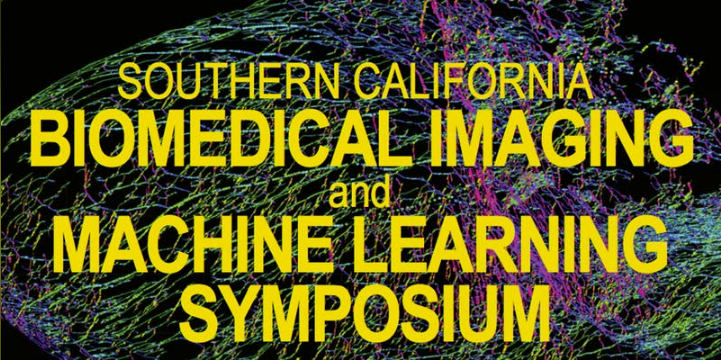Previous Symposiums
The Southern California AI & Biomedicine Symposium returns for 2022.
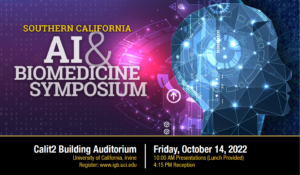

Southern California Biomedical Imaging and Machine Learning Symposium
Friday, October 4, 2019
Calit2 Auditorium (Building # 325), UC Irvine
2019 Biomedical Imaging Symposium program

7th Annual Southern California Microbiome Symposium
Friday, September 20, 2019
Calit2 Auditorium (Building # 325), UC Irvine
2019 MicrobiomeSymposium program
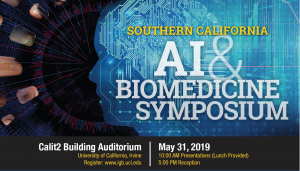 Southern California AI and Biomedicine Symposium
Southern California AI and Biomedicine Symposium
Friday, May 31, 2019
Calit2 Auditorium (Building # 325), UC Irvine
2019 Southern California AI and Biomedicine Symposium program
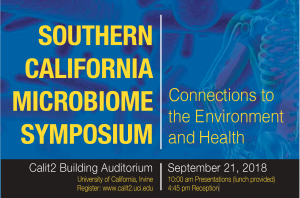 Southern California Microbiome Symposium – Connections to the Environment and Health
Southern California Microbiome Symposium – Connections to the Environment and Health
Friday, September 21, 2018
Calit2 Auditorium (Building # 325), UC Irvine
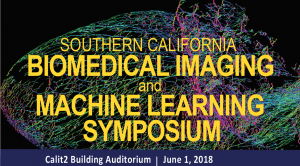 Southern California Biomedical Imaging and Machine Learning Symposium
Southern California Biomedical Imaging and Machine Learning Symposium
Friday, June 1, 2018
Calit2 Auditorium (Building # 325), UC Irvine
2018 Biomedical Imaging and Machine Learning Symposium program
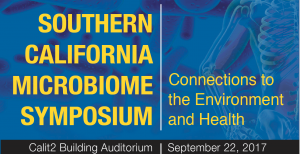 Southern California Microbiome Symposium – Connections to the Environment and Health
Southern California Microbiome Symposium – Connections to the Environment and Health
Friday, September 22, 2017
Calit2 Auditorium (Building # 325), UC Irvine
2017 Microbiome Symposium Program
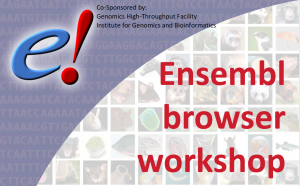 Ensembl Workshop
Ensembl Workshop
Thursday, May 4, 2017
Donald Bren Hall 4011, UC Irvine
Ensembl Workshop program revised
 2017 RNA Symposium
2017 RNA Symposium
April 14, 2017
Calit2 Auditorium (Building #325), UC Irvine
Southern California Microbiome Symposium – Connections to the Environment and Health
Friday, September 23, 2016
Calit2 Auditorium (Building # 325), UC Irvine
Southern California Machine Learning Symposium
Co-Organized by IGB, Calit2, and the Data Science Initiative
Friday, May 20, 2016, 9 AM to 8 PM
UCI Student Center, Pacific Ballroom A,B, and C, UC Irvine
New Rules You Need To Know For NIH Grant Applications In Genomics
Tuesday September 29, 2015, 11 AM to 1 PM
105 Sprague Hall, UC Irvine
Microbiome Connections to Environment and Health Symposium
September 25, 2015
Calit2 Auditorium (Building # 325), UC Irvine
RNA Symposium
April 24, 2015
Calit2 Auditorium (Building #325), UC Irvine
ACM BCB: The 5th ACM Conference on Bioinformatics, Computational Biology and Health Informatics
September 20-23, 2014
Newport Beach Marriott Hotel and Spa, Newport Beach, CA
Microbiome Connections to Environment, Health and Disease Symposium
September 19, 2014
Calit2 Auditorium (Building # 325), UC Irvine
Epigenetics Symposium
December 12-13, 2013
Beckman Center of the National Academies of Sciences and Engineering, Irvine, CA
This is the second of a series of symposia on epigenetics and chromatin research aimed at bringing together the scientific community of Southern California. The focus of this two-day Symposium is on the most recent and exciting findings that have implicated various epigenetic and chromatin remodeling pathways in cellular and physiological responses. This Symposium is organized by the Center for Epigenetics and Metabolism, together with INSERM Unite 904 and the Institute for Genomics and Bioinformatics at UCI.
The Symposium will be followed by a workshop with Pierre Baldi and Matteo Pellegrini on emerging methodologies and the use of biocomputing in genomics and epigenomics.
Microbiome Connections to Health and Disease Symposium
September 24, 2013
Calit2 Auditorium (Building # 325), UC Irvine
High-Throughput Sequencing and Other Methods: from Technology to Discovery
Thursday, June 7, 2012
Donald Bren Hall (Building #314), Room 6011, UC Irvine
HTS to P4 Medicine at UCI
Friday, February 18, 2011
Calit2 Auditorium (Building # 325), UC Irvine
2011 Biomedical Informatics Training (BIT) Program Symposium
Thursday, May 19 2011
Donald Bren Hall (Building #314), Room 6011, UC Irvine
This years topic is about High–throughput sequencing coupled to chromatin immuno–precipitation (ChIP–Seq) is widely used in characterizing genome–wide binding patterns of transcription factors, cofactors, chromatin modifiers, and other DNA binding proteins. A key step in ChIP–Seq data analysis is to map short reads from high–throughput sequencing to a reference genome and identify peak regions enriched with short reads. Although several methods have been proposed for ChIP–Seq analysis, most existing methods only consider reads that can be uniquely placed in the reference genome, and therefore have low power for detecting peaks located within repeat sequences. Here we introduce a probabilistic approach for ChIP–Seq data analysis which utilizes all reads, providing a truly genome–wide view of binding patterns. Reads are modeled using a mixture model corresponding to K enriched regions and a null genomic background. We use maximum likelihood to estimate the locations of the enriched regions, and implement an expectation–maximization (E–M) algorithm, called AREM, to update the alignment probabilities of each read to different genomic locations.
Transposable Elements (Mobile DNA Symposium)
Friday, Feb 19, 2010, 11:00am to 5:00pm
Calit2 Auditorium (Building # 325), UC Irvine
The symposium will include discussion of DNAs that mobilize to cause surface antigenic variation in bacteria, retroelements that cause mutations in human germline DNA, cut and paste DNA elements used in genetic engineering and elements in yeast and plants that by accumulating in specific regions may drive chromosomal function itself and even ribozymes that occur in viruses as well as host genomes. The Mobile DNA Symposium will feature two outside speakers, Dr. John Moran, U. Michigan and Dr. Peter Atkinson, U. Riverside. Dr. Moran studies human LINE element mobility in embryonic cells and Dr. Atkinson studies applications of hAT DNA cut and paste elements in genetic engineering. However, a major goal of the Symposium is to bring together for the first time, faculty from UCI who study transposable elements in bacteria, yeast, mosquitoes, plants, and the test tube! We hope to see you there.
2010 Biomedical Informatics Training (BIT) Program Symposium
May 19, 2010
Donald Bren Hall (Building #314), Room 6011, UC Irvine
This symposium brings opportunity for the BIT predoctoral and postdoctoral trainees to present their theses and postdoctoral research projects. The NIH–NLM funded Biomedical Informatics Training (BIT) Program provides in–depth training to students in either computational or life sciences, and trains them to working competence in the cross–discipline with emphases in bioinformatics approaches to problems in molecular structure/function prediction and determination, comparative and functional genomics, chemical informatics, and computational and systems biology.
Systems Biology of Stem Cells
May 24–25, 2010
Beckman Center, 100 Academy Irvine, CA 92617
The Systems Biology of Stem Cells Symposium, to be held in Irvine, California, May 24–25, 2010, is devoted to state–of–the art research at the intersection between systems biology and stem cell biology. Topics will include stem cell genomics and epigenomics; gene regulatory networks underlying pluripotency; feedback regulation of proliferation and lineage progression; and cancer stem cells. A diverse set of experimental, mathematical and computational methodologies will be represented among the featured talks. Meeting activities will include a poster session and a banquet on May 25th.
Foundations of Statistics Seminar Series
March 12, 2010
Donald Bren Hall, Room 6011
Monday, April 26, 2010
4:00–5:00pm
2011 Donald Bren Hall
Increasingly, data are being gathered to investigate the behavior of extremes of a process over space and time. By now, there is a considerable literature addressing this problem. This talk will focus on modeling for such a setting. In particular, there are several paths that can be taken to formulate such stochastic specifications. We can model the process directly and study the induced behavior for extremes. Though, perhaps attractive, this is very computationally demanding. We can model the sampled extremes directly, drawing upon the elegant characterizations of max–stable processes that have appeared in the literature. This approach runs into computational challenges as well, though recent work using composite likelihood ideas is promising. We can model the data in a hierarchical fashion, introducing a latent process model. Now, we have at our disposal rich and easily interpretable specifications and have access to familiar MCMC model–fitting machinery. After some review and discussion of the first two possibilities, we focus on the last, illuminating the range of modeling that is available and the computational issues. We illustrate with temperature and precipitation data from South Africa from 1950–2000. Finally, some new extensions using Dirichlet Process mixing will be proposed.

